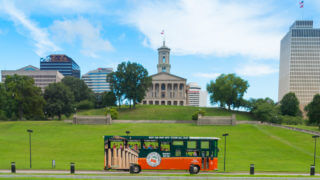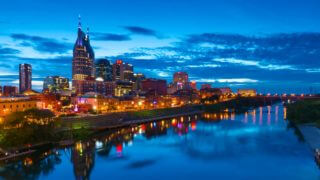Most Historic Sites in Nashville
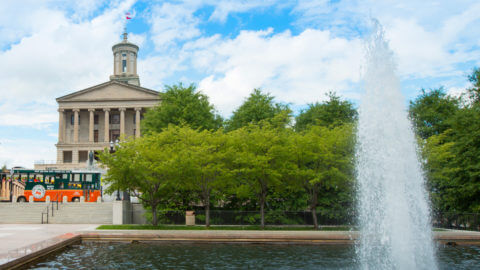
From its founding as a backcountry trading post to its ascendancy as the “Country Music Capital of the World,” Nashville has played a significant role in the nation’s history for over two centuries. The city offers historic landmarks, buildings, museums and attractions that are fun and educational for the whole family. Located in and around Music City, several of these historic places are stops along the Old Town Trolley Tour, making it easy to visit and learn more about these popular attractions. This guide will help you explore the city’s fascinating historic sites while on vacation.
Music City Landmarks
Many of the city’s iconic sites have been featured in movies, television shows and music videos.
John Seigenthaler Pedestrian Bridge
Crossing the Cumberland River east of downtown, the John Seigenthaler Pedestrian Bridge was built in 1909. It connects Nashville’s riverfront parks and provides foot access to the Nissan Stadium. The span incorporates the only concrete trusses in Tennessee. Offering excellent views of the city skyline, the July 4 fireworks and traffic on the water below, the bridge is dramatically illuminated at night. A symbol of the city, it is also featured in numerous country music videos.
 Ryman Auditorium
Ryman Auditorium
Known as the “Mother Church of Country Music” and the longtime home of the Grand Ole Opry, Ryman Auditorium is one of the most easily recognized buildings in Nashville. The auditorium first opened its doors in 1892 as a church and gradually began to host secular performances. The Grand Ole Opry broadcast from the Ryman for more than 30 years. This national showpiece still hosts performances by legendary artists and provides a high-tech tour that takes fans back to the building’s iconic heydays.
Marathon Village
Originally housing the Marathon Motor Works, a turn-of-the-century Nashville-based vehicle manufacturer, the repurposed factory was built in 1881. This National Historic Landmark now houses a variety of commercial and event spaces. The four-building complex is home to unique retailers like a tasting room for the historic Green Brier Distillery and Antique Archaeology, which is also the filming location for the American Pickers show on History Channel. You can also grab a cup of coffee, pick up a Nashville moment at an artisanal shop or satisfy your sweet tooth with a sugary treat.
Belcourt Theatre
Opened as the Hillsboro Theatre in 1925, the Belcourt Theatre initially was a silent movie house that featured the most technologically advanced projection equipment of the period. Boasting the largest stage in the city, the theater began to host live performances as well. During the 1930s, the Belcourt was home to the Grand Ole Opry. The building’s intimate atmosphere heavily influenced the format of the popular country music program.
Historic, Surprising and Must-See Architecture
Nashville is home to several unique architectural gems that are listed on the national register.
 Downtown Presbyterian Church
Downtown Presbyterian Church
The Downtown Presbyterian Church, also known as the Old First Presbyterian Church, opened its doors in 1848. It is the third church to occupy the site; the first was built in 1816. Designed by noted architect William Strickland, the twin-tower edifice is one of the few remaining examples of Egyptian Revival architecture in the country. Andrew Jackson attended services here and it was used as a hospital during the Civil War.
 Tennessee State Capitol
Tennessee State Capitol
Also designed by William Strickland who is interred above the cornerstone, the Tennessee State Capitol was completed in 1859. Outfitted with a distinctive tower, this Greek Revival-style edifice was used as a fort by Union soldiers during the Civil War. The interior of this National Historic Landmark features works of art, frescos, murals and ornate chandeliers. The capitol grounds include several noteworthy statues along with the tombs of President James Polk and First Lady Sarah Polk.
 The Parthenon
The Parthenon
The Parthenon is located in Centennial Park and is one of the city’s most prized buildings. Built in 1897 for the Centennial Exposition, it is a full-sized model of the ancient Athenian shrine. The architectural details are direct casts of the original features that adorned the pediments of the classical Greek building. The Parthenon houses a permanent and rotating collection of art as well as the 42-foot-tall statue of Athena, the tallest indoor sculpture in the country.
 Union Station
Union Station
Opening in 1900, the American Victorian Romanesque Revival-style edifice was formerly adjacent to one of the world’s largest train sheds. The station harkens back to the zenith of train travel and Nashville’s transportation legacy. Now a luxury hotel, Union Station features a lobby with a 65-foot-tall, barrel-vaulted, Tiffany stained glass ceiling as well as Italian marble architectural details, polished oak doors and gold-accented bas-relief figurines.
Where Nashville’s Past Comes Alive
Before Nashville was founded, the area was home to Native Americans and intrepid pioneers. It became a place where folks would stake their future on trade, transportation and music.
Tennessee State Museum
Housing a collection of artifacts and memorabilia, the history of the Volunteer State comes alive with the interactive exhibits of the Tennessee State Museum. The displays chronicle the cultural heritage and natural history of the state from prehistoric times until the present day. The museum is located inside the James K. Polk building, which is also home to the Tennessee Performing Arts Center. Features include artwork, furniture, handmade crafts and military equipment.
 Bicentennial Mall State Park
Bicentennial Mall State Park
Travel through the history of the Volunteer State as you stroll past the Pathway of History, a granite wall inscribed with various important cultural events. An inlaid granite map and fountains outline the geographic and water features of Tennessee. The Bicentennial Mall State Park also has a 95-bell carillon, a unique memorial to the veterans of World War II and a 2,000-seat amphitheater. Costumed re-enactors relay stories of memorable events and people like Davy Crockett and Alvin York.
 Natchez Trace
Natchez Trace
Dating back centuries, the Natchez Trace is a historic hunting and migration route from the Mississippi Delta to the Cumberland River. Used by Native Americans, trappers and pioneers, the northern terminus of the trace is situated near Nashville. Scenic overlooks provide the opportunity to view the countryside ablaze with colors during the spring and fall foliage seasons.
 Belmont Mansion
Belmont Mansion
Home to Adelicia Acklen, one of the wealthiest women during the Civil War period, Belmont Mansion is a well-preserved reminder of life during the 19th century. The beautiful, 10,000-square-foot antebellum manor chronicles the life and legacy of its mistress. As the largest house museum in Tennessee, the elegantly furnished mansion features original architectural details like Venetian glass that adorns many windows, doors and transoms. The home also includes several acres of landscaped gardens.
Nashville’s Historic Surroundings
The area around downtown Nashville also contains historic places commonly associated with the city’s pioneer, antebellum and Victorian-era heritage.
Belle Meade Plantation
5025 Haring Pike
Built in 1807, this stately antebellum mansion reflects the history of the Old South from slavery until the end of the Civil War. The Victorian-style manor house is a museum furnished with Harding family heirlooms and other period pieces. The house bears the scars of cannon balls fired during a nearby battle that spilled onto the front lawn. Situated on 30 rolling acres, the plantation includes eight outbuildings, including Dunham Station’s cabin. Famed racehorses Seabiscuit, War Admiral and Secretariat trace their lineage to the plantation’s thoroughbred nursery.
The Hermitage
4580 Rachel’s Lane
The home of President Andrew Jackson, the Hermitage dates from 1804. Situated on a site selected by his wife Rachel, the property was originally occupied by a log cabin. Over the ensuing decades, Jackson built and remodeled a larger plantation home. The current Greek Revival-style structure with its decorative interior was constructed in 1835. More than 95 percent of the home’s furnishings are original and belonged to the Jackson family. The 1,100-acre estate includes gardens and replica slave quarters as well as the graves of the president and his wife.
Fort Negley Park
1100 Fort Negley Boulevard
Built in 1862 by Union forces occupying Nashville, Fort Negley is the largest inland fortification erected during the Civil War. Newly freed and enslaved African-Americans performed most of the construction of the 180,000-square-foot bastion. Because the 1864 Battle of Nashville took place further south, the fort never fired a shot. The preserved remains of this limestone, star-shaped citadel sit atop a hill a few miles south of downtown. The park is now listed on the National Register of Historic Places.
Cheekwood Botanical Garden and Museum
1200 Forrest Park Drive
Dating from the late 1920s, the Cheekwood Botanical Garden and Museum of Art features a mesmerizing array of colorful plantings, including boxwoods, crape myrtles and Japanese maples. The grounds are separated into various themed gardens and terraces, such as the wildflower, meditation, perennial and herb gardens. In addition to 55 acres of awe-inspiring scenery, the Georgian-style museum highlights a collection of American art as well as decorative pieces from around the world.

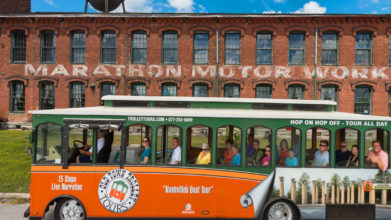


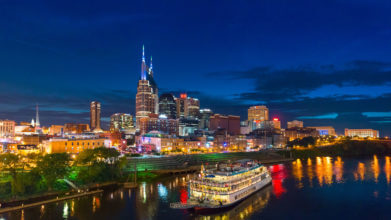
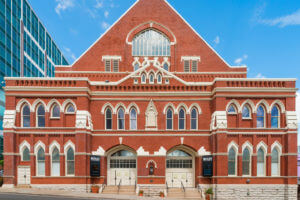 Ryman Auditorium
Ryman Auditorium Downtown Presbyterian Church
Downtown Presbyterian Church Tennessee State Capitol
Tennessee State Capitol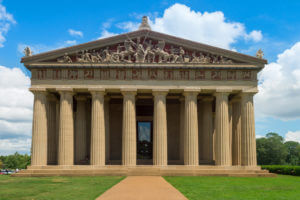
 Union Station
Union Station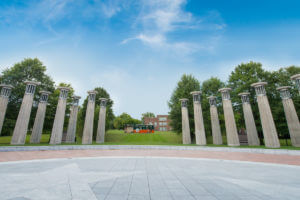 Bicentennial Mall State Park
Bicentennial Mall State Park Natchez Trace
Natchez Trace
